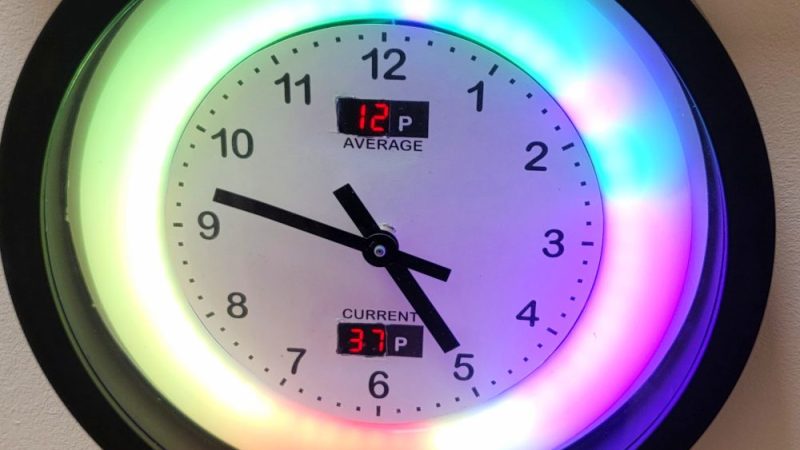On the surface, the electric grid might seem like a solved piece of infrastructure. But there’s actually been a large amount of computerized modernization going in the background for the past decade or so. At a large scale this means automatic control of the grid, but for some electric utility customers like [Alex] this means the rates for electricity can change every hour based on demand. By keeping an eye on the current rate, you can extract the most value from these utilities.
[Alex] is located in the United Kingdom and has an energy provider whose rates can change every half hour. This information is freely available well enough in advance to download the data and display it visibly in with a NeoPixel LED ring around a clock. The colors displayed by the LEDs represent an increase or decrease in price for the corresponding time and allow him to better plan out the household’s energy use for the day. The clock uses a TinyPICO ESP32 module to gather the data and handle the clock display. A second wall-mounted device shows real-time energy readings for both gas and electricity using two old analog voltmeters modified to display kilowatt-hours.
While not everyone has a utility which allows this sort of granularity with energy pricing, having one can make a bit of a difference as electricity rates under this system can sometimes go negative. [Alex] estimates that using these two displays to coordinate his energy usage has saved around £50 a month. Even if your utility offers minimal or no price adjustments for time-of-use, it’s still a good idea to monitor energy use in your home. Here’s a fairly comprehensive project that does that without modifying any existing wiring.

















Price for electricity here same night or day. The bill shows me how much I’ve used. Same with NG. Simple.
Neat project for the use case though :) .
When we were living in North Yorkshire, UK, one of the first things a new resident needs to choose is a power supplier, and man was there variation in tariffs among them. If you choose a supplier with a flat rate per kWh or m3 that you’re happy with – if you’re in the UK at all – good on you. Even in the US, time-of-day rates are an option with many utilities.
Not here in my part of USA. But we are seeing solar and wind driving up cost of electricity as forced to take the energy when available…. So it goes. I work for our state’s utility BTW.
To be fair, depending which part of the grid you look at, sometimes it isn’t all about where the electricity comes from. Sometimes there’s a day that’s hotter or colder than predicted, and the peaker plants are shocked and astounded that you are asking them to deliver power in these conditions like they’re supposed to do. :P
They’re not an option in my part of the US. They’re a requirement. Additionally, there are multipliers that are applied according to the highest usage hour, or some such goofy money grab. We manage usage around the extremes, which I guess is allegedly the point to the whole scheme.
Nowadays, margins are pretty thin everywhere. It’s becoming too hard or expensive to regulate supply to perfectly match demand, so we should all anticipate to see rapidly adjusted prices becoming more common even residentially as a way to control instantaneous demand. Plus tiered plans or slower adjustments to try and regulate average long term demand. Even where I am, with cheap coal and no daily price swing or price tiers, the base price of power on my bill can be almost double during peak months versus what it is in fall and spring.
In Korea the price is fixed, but tiered. You get a certain amount at the cheapest rate, which is enough for most households with modest usage. As you use more and go up to the next tier the additional units are priced higher.
What this means is that “normal” usage is not too expensive, and households don’t need to worry about the basic bill. There is also no limit to how much you use, but there is an incentive to manage your usage to avoid going into higher tiers that month.
In addition there is no standing charge. Win win!
Doesn’t work if your electricity service has been privatised and their only goal is to price gouge to maximise profits.
You think you government control won’t try to maximize profits? Privatization isn’t the problem it’s lake of real competition. I only have one choice where I live.
Privatisation is entirely the problem.
Okay but why do you think that? Government controlled seems similar to privatization except without competition.
Not at all. At least not in practice, where I live here. People see it as their government’s fault and vote them out if the prices increase. The govt has a huge incentive to keep the prices down.
Privatisation with government interference is the issue. The market forces can’t apply properly when there’s price caps, feed in tariffs, subsidies for wind farms when they’re turned off, etc.
With the amount of regulation we’ve got now, it’s only private in name.
I’m sure this will soon fall to the same arguments people use to shoot down overage internet.
This is the most Dad-turning-out-all-the-lights-in-the-house-grumbling-about-bills invention ever made. I want one
Great project when you have a varying price for electricity.
The Dad-turns-out-the-lights comment also reminds me of an invention I’ve long wanted to see, but never have: A people-detector that *gradually* turns off the lights when rooms are unoccupied. The goal is to make it less noticeable than simply turning them on/off with the usual motion detector.
I’ll bite. Why do you care if it’s not noticeable. If there’s people in the room, they will notice eventually. If not, they shouldn’t care?
Motion sensors only work when there is motion, something there is very little of when I’m reading a book or listening to music. I have something similar set up and when I go still for a while, I notice the lights starting to dim and I wave my hand so they fade back to full brightness. Having the lights frequently drop out on you when you’re trying to relax is kind of counter productive.
Also, just because you’re not in the room doesn’t mean the lights therein aren’t spilling over into the room you’re occupying. It’s nice when the lights just fade out and you’re not quite as aware of your home’s automation. For me, this is a secondary effect. It’s more pleasant when your home automation does things for you without you noticing it going on.
The presence detection is available already; search for “aqara fp2 presence sensor”.
The action(s) based on presence is some scripting/shortcuts on your home automation platform of choice.
They already exist, they are called occupancy sensors and they shut down certain banks of led lights in our offices when workstations are not occupied but are programmed with a minimum safety level when anyone remains. This particular system was made by Lutron about 20 years ago.
Good reminder if you’re living in the UK to ignore the incessant calls to install a “smart” meter. You know something’s up when they start impersonating Albert Einstein on adverts to try and convince you to install one.
What makes you think that a utility company would adjust rates in a fair manner? Please dont tell me you are going to rely on the government to ensure they dont game the system.
If I’m not happy with a fixed price electricity package I can switch to using the market spot price (+ company margin), not much room for unfair adjustments there
It depends on whether or not you have a functional government I suppose.